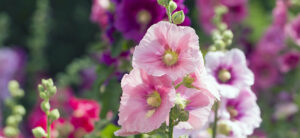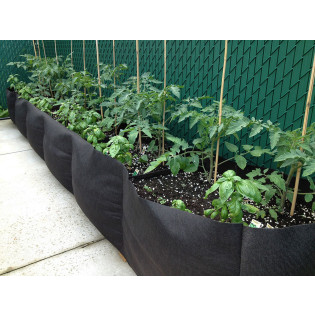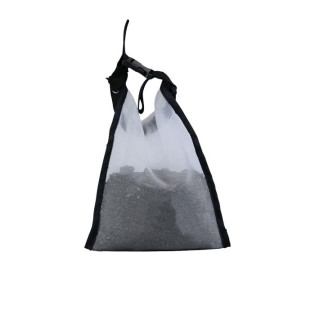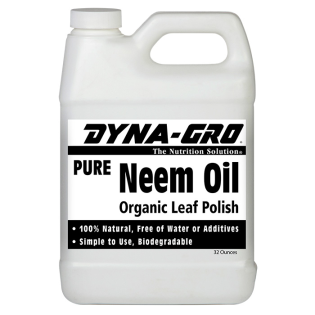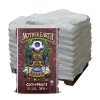
If you are seeking out the next addition to your garden, consider learning how to grow hollyhocks from seed.
A classic garden plant, the hollyhock, or Alcea rosea, is a flower that grows easily in zones 3-8.
Though it may only bloom as a biennial, this flower can be grown as a short-lived perennial in many situations.
During the first year of growth, the plant will spend its energy on growing new foliage and becoming stronger, while in the second, gorgeous flowers will appear.
Worth the wait? Absolutely.
Once you know how to grow hollyhocks, you won’t mind a bit of delayed gratification.
In this article, we're going to teach you how to grow hollyhocks from seed to bloom, so you can enjoy gorgeous flowers year in and year out.
What Are Hollyhocks?
Hollyhocks are flowers that are often considered staples in the classic cottage garden. They bloom in the middle of the summer, producing multiple blossoms on towering spikes.

These flowers require minimal care and are known as being valuable flowers when it comes to wildlife and pollinator health. By planting these in your backyard, you'll be improving the overall eco-system surrounding your home.
In fact, they are crucial when it comes to the support of the lifecycle of the painted lady butterfly (they’re also valuable when it comes to serving as a host plant for caterpillars and attracting pollinators like hummingbirds and bees).
Growing up to eight feet tall and two feet wide, hollyhocks bloom from June until August. They can be found in just about any color, including pink, blue, red, purple, yellow, white - even black is an option!
Are Hollyhocks Easy To Grow?
A garden favorite, the hollyhock is known for being very easy to grow. There are very few plants that you can simply plant and forget, but this one is as close as it gets.
As long as you can provide your plants with a warm, sunny location that is sheltered from the wind, you shouldn’t have much trouble growing these beautiful flowers.
Are Hollyhocks Perennial Plants?
Many gardeners first consider whether a plant is a perennial or annual before planting it in their garden. If you aren't sure what this means, check out our comparison post (linked above).
Hollyhocks are unique flowers in that they are sometimes considered annual, sometimes biennial, and sometimes short-lived perennials.
Bceause they live for more than one year, many people consider them short-lived perennials.
However, they are technically biennial in that they spend the first year of life building rootstock and storing energy and the second year (and beyond) in flowering.
What leads to much of the confusion is that many gardeners purchase hollyhocks from a nursery. These will likely only flower the first year and then die (that’s because you’ve purchased a two-year-old plant).
Hollyhocks do often reseed on their own, however, which leads many people to the assumption that they are perennial.
Where Is The Best Place To Grow Hollyhocks?
Here at Hydrobuilde, we're all for indoor growing - it offers tons of benefits over outdoor growing.
However, this is one plant that is best grown in the backyard in large containers, if not a raised garden bed so these mammoths have ample space to grow to their full potential.
Hollyhocks grow to large sizes - up to eight or nine feet! - so if you want them to reach their full potential, plant them outside in the garden.
The location should have full sun exposure and contain well-draining soil. If you can, choose a location that is sheltered from damaging winds - such as a greenhouse.
You may want to provide support for these statuesque blooms, too, such as a trellis setup.
Understanding the Hollyhocks Life Cycle
The hollyhock has a unique life cycle that’s important to understand if you plan on growing these flowers in your garden.
During the first year, hollyhocks won’t usually bloom. They will instead spend their energy on setting roots and storing nutrients.
They will bloom in the second year. After that, hollyhocks have the added benefit of reseeding themselves.
When they die, there's a good chance that they’ll come back next season to continue growing.
That said, in an area that receives a hard freeze during the winter, you can grow your hollyhocks as annuals, starting the seeds in containers and then overwintering inside.
What Is Needed To Grow Hollyhocks?
Growing hollyhocks is easy as long as you have the right gear. For starters, you’ll want some good potting soil with excellent drainage along with garden pots to plant your seeds into.
Fabric pots are a good choice, as they’ll offer excellent drainage and ventilation. You will also need plenty of natural sunlight and some kind of light fertilizer to feed your plants.
You can also mix a few organic amendments into your potting soil to help add nutrition.
How To Grow Hollyhocks In Your Backyard
Now, we are going to teach you how to grow hollyhocks from seed to bloom from the comfort of your own home. Like we mentioned earlier, these plants are super low maintenance once you get them rooted and growing.
Let's start with the most important part - starting your hollyhock seeds.
How To Plant Hollyhocks Seeds
Hollyhocks can easily be started from seed indoors. If you do this, start your seeds about nine weeks before the last frost date. This gives you the ability to get your plants started early and get a jump start on the growing season.
You can place the seedlings outside about three weeks after this frost. You can also sow seeds directly outdoors, waiting until one week after the last frost to do so.
Whichever option you choose, sow your seeds about ¼ inch deep and roughly two feet apart. These flowers have long taproots, so you may find it necessary to plant seeds into tall, individual pots and to transplant them early on in their growth to prevent any damage later on.
When you are ready to plant, do so in a well-draining area where your hollyhocks will receive full sun to partial shade.
Feeding Your Hollyhocks Plants
Applying a light application of fertilizer or compost tea when you plant, or first thing each spring, can also be beneficial.
Provide regular water for your hollyhock plants, making sure the soil stays moist at all times when the plants are still becoming established.
Once they have set good roots, they are pretty drought tolerant and can meet most of their moisture needs from natural rainfall.
Mulching can help your hollyhock plants stay adequately moist and will also supply nutrients back to the soil, if you choose an organic mulch like straw or compost.
It can suppress weeds around your hollyhock plants as well, reducing your overall gardening chores.
Pruning Your Hollyhocks Plants
You will need to prune your hollyhock flowers back, removing them as they fade. The stalks can be cut after flowering, too.
This will prevent seed heads from forming. However, you should allow this process to occur at the end of the season so that they set seeds for next spring.
Monitoring Hollyhocks Diseases & Problems
Hollyhocks are prone to a disease known as hollyhock rust. This fungal disease shows up first as yellows spots on leaves before creating brown bumps on the underside of the leaves.
It’s far easier to prevent this disease than it is to get rid of it. To prevent rust, water from below and provide good air circulation by following spacing guidelines.

If you notice signs of rust on the plant leaves, you may need to remove them to stop the fungal disease from spreading to other plants.
Anthracnose is another common fungal disease. This, too, can be prevented by following proper watering regimens and can usually be treated with a fungicide.
When it comes to pests, watch out for spider mites, snails, slugs, thrips, sawflies, and Japanese beetles. Occasionally, these flowers will also be munched on by deer, so consider investing in garden fencing.
Preparing Hollyhocks To Survive A Winter
Hollyhocks can be grown in a wide range of growing zones and conditions, but fortunately, that doesn’t mean you need to dig them up at the end of the cycle.
Instead, you just need to take a few steps to prepare them to survive the winter. To do this, cut the stalks off of each plant at the soil line.
Throw out the stalks after you harvest the seeds. Cover the bed where your flowers are planted with a thick layer of mulch.
This will insulate the ground where the roots will rest during the winter.
Final Thoughts On How To Grow Hollyhocks
Are you ready to start growing this garden favorite in your backyard? The hollyhock is a classic choice for beginning and expert gardeners alike.
No matter what look you might be trying to achieve with your garden, consider growing hollyhocks to take things to the next level.
You can pick up all the growing supplies you need at Hydrobuilder, and set yourself up for a successful, beautiful garden.





